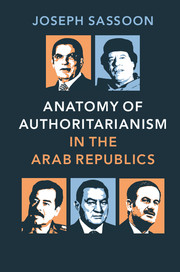Book contents
- Frontmatter
- Dedication
- Contents
- List of tables
- Acknowledgments
- Notes on transliteration
- Glossary and abbreviations
- Map of the eight Arab republics
- Introduction
- 1 Political memoirs in the Arab republics
- 2 Party and governance
- 3 The military
- 4 The role of security services in the Arab republics
- 5 Economy and finance
- 6 Leadership and the cult of personality
- 7 Transition from authoritarianism
- Conclusion
- Appendix Timeline of major events in the Arab republics
- Bibliography
- Index
5 - Economy and finance
Published online by Cambridge University Press: 05 March 2016
- Frontmatter
- Dedication
- Contents
- List of tables
- Acknowledgments
- Notes on transliteration
- Glossary and abbreviations
- Map of the eight Arab republics
- Introduction
- 1 Political memoirs in the Arab republics
- 2 Party and governance
- 3 The military
- 4 The role of security services in the Arab republics
- 5 Economy and finance
- 6 Leadership and the cult of personality
- 7 Transition from authoritarianism
- Conclusion
- Appendix Timeline of major events in the Arab republics
- Bibliography
- Index
Summary
Since the Arab uprising, scholars have made extensive attempts to analyze the reasons for the dramatic changes that swept across five Arab republics and indirectly impacted other republics. Economic factors undoubtedly played an important part in the dislocation of the authoritarian regimes. Although economic performance in the eight republics varied dramatically, from high gross domestic product (GDP) per capita in countries such as Libya to very low GDP in Yemen (see Table 5.1), they nevertheless shared a number of characteristics.
First, during the past four decades, significant progress was made in areas such as illiteracy and life expectancy. Second, an enormous expansion of bureaucracy took place and a pervasive central government apparatus dominated these republics. Third, a command economy prevailed, in which decisions made by the leadership relied on the heavily bureaucratic system. Fourth, patronage of elite groups became fundamental, and many republics used economic liberalization to reinforce political control. Fifth, little or no emphasis was placed on formulating economic policy and properly running the finances. Most leaders focused more on consolidating their power, and economic management only came to the fore during national or international financial crises. As a result, the number of memoirs written by political actors and leaders centering on economic issues are more limited, and many of those discussed here belong to senior officials working in the economic ministries or to commentators who closely followed their countries’ economic trajectories. It is remarkable how little attention was paid to economic affairs even by those who occupied senior positions in finance and the economy. Two examples: Ahmed Mestiri, who was minister of finance and commerce in Tunisia from 1958 to 1960, devotes only nine pages to this in his more than 350-page memoir; and in 'Abd al-Rahman al-Iryani's more than 600 pages, no more than a couple are dedicated to the economy of Yemen even though he was the president for seven years (1967–74), during which the country suffered severe economic and development problems.
Apart from these common denominators mentioned, the whole region suffered from similar problems. An ex-minister of economy in Lebanon during the 1950s, who later became a financial and economic consultant for the region, summed them up: (1) a low ratio of workers to the overall population (45 percent versus 61 percent for the rest of the world); (2) high youth unemployment averaging 25 percent, […]
- Type
- Chapter
- Information
- Anatomy of Authoritarianism in the Arab Republics , pp. 156 - 184Publisher: Cambridge University PressPrint publication year: 2016

